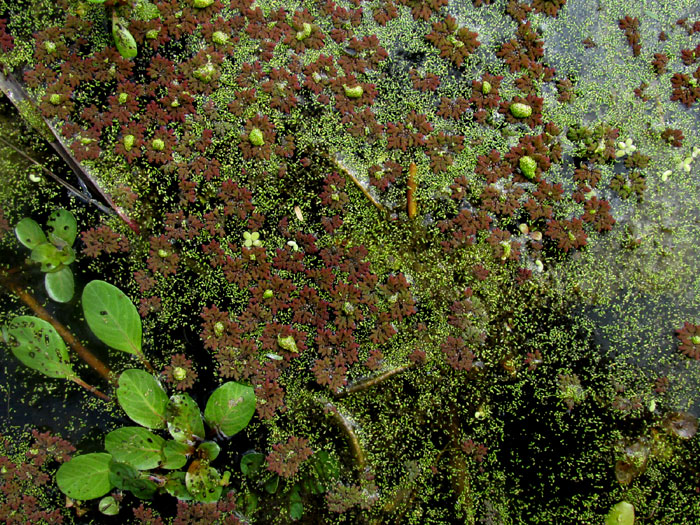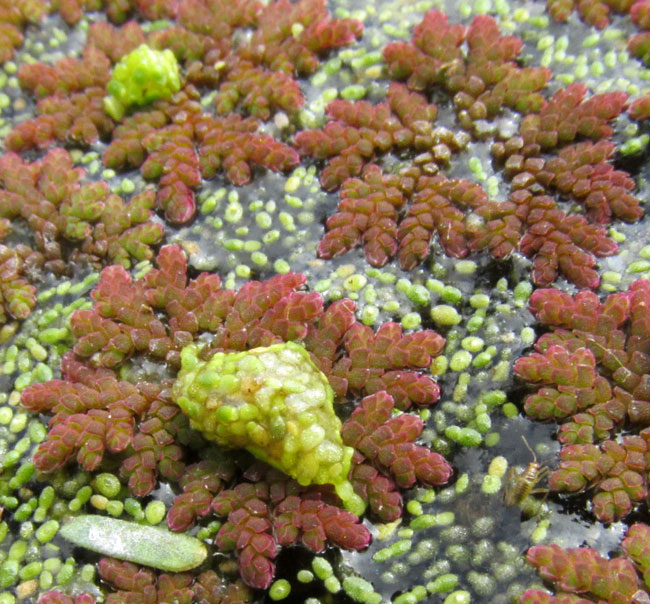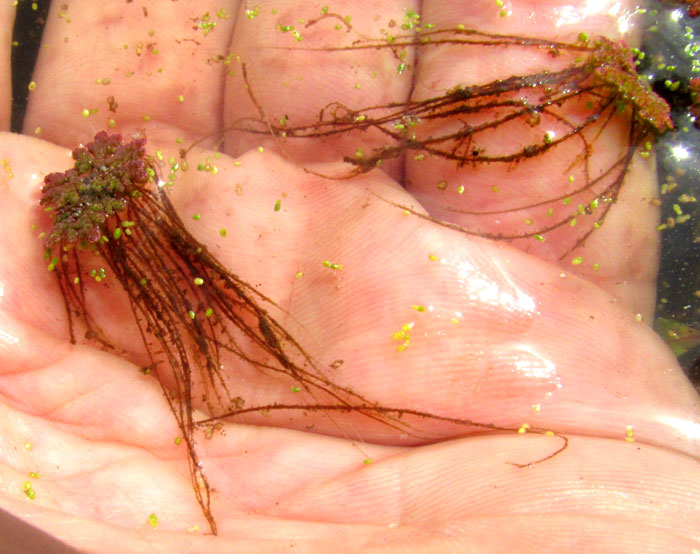Excerpts from Jim Conrad's
Naturalist Newsletter
entry dated September 7, 2022, issued from near Tequisquiapan, elevation about 1,900m (6200 ft), N20.565°, W99.890°, Querétaro state, MÉXICO
MOSQUITO FERNS

Above you see a small part of a small pond whose surface is totally covered with floating vegetation just like what's shown. At the picture's lower, left, the emergent broad leaves belong to Floating Primrose Willow rooted in mud on the pond's bottom. The tiny, green, oval items floating on the water like confetti are Brazilian Watermeal. It's the larger, reddish-brown items floating amid the watermeal that caught my attention.
Of several ponds in the area covered with watermeal and Fat Duckweed, this is the only one with the reddish-brown things. Maybe it's because, of all the little ponds in the area, this is the only one that retained water during the entire dry season, fed by runoff from irrigated fields in which enormous amounts of groundwater were wasted by overwatering by large landowners, apparently through negligence.
The brown things are unusual, but what about the yellow-green blobs in the center of many of them?

The green blobs occupied the centers of only some of the brown things, and in most of the pond the brown things carried no green blobs at all.

No duckweed has its vegetative parts so intricately divided into scale-like sections as the above brown item. However, like duckweeds, the brown floating plants bore roots on their undersides which dangled in the water:

A closer look at the roots and the configuration of the scaly upper part just led to more confusion:

If I'd been a young naturalist having never met something like the Giant Salvinia fern, I'd never have figured this aquatic plant's identity. However, once I began thinking about ferns, it didn't take long to settle on the mosquito ferns, genus AZOLLA, in the quirky little Mosquito Fern Family (one genus, maybe 7 species worldwide), the AZOLLACEAE.
The Flora of North America tells us at the start that "The species of Azolla are difficult taxonomically because (1) about 80% of the specimens lack sori, which are necessary for identification, and (2) the characteristics needed to identify the species are difficult to observe." It's added that during the identification process a light microscope is needed to see the number of cells per hair on the upper leaf lobes, and, even worse, a scanning electron microscope is required to see sculpturing megaspore surfaces. Also, the identities of most specimens cited in the literature is questionable, and species' distribution maps are imprecise, yet knowing which species are found where is important.
Therefore, people in our position without electron microscopes mostly can only gawk at these little plants, and marvel at such novel and important little beings.
If you've become accustomed to ferns being ferny-looking, when it comes to mosquito ferns you have to reconfigure all your thinking. With mosquito ferns, the fern is the whole, doily-like, reddish-brown structure. That structure readily breaks apart into stem segments, or branches, which keep growing. In fact, "fragmentation" is the mosquito fern's most commonly used reproduction method. That's part of the reason how, under ideal conditions, mosquito ferns can double their biomass in three days.
As with all ferns, mosquito ferns sexually reproduce with spores. However, unlike most ferns, they produce two kinds of spores, male and female. Spores are produced in roundish packages called "sporocarps," which are analogous to the spore-producing sori of most ferns. Male sporocarps, which grow up to about 2mm across (0.08 inch) are packed with numerous tiny microsporangia, and inside each microsporangium reside 32 or 64 male spores, or microspores. You can imagine how small these male spores are. The female sporocarp, which contains just one sporangium and a single functional spore, is considerably smaller than the male one.
Apparently the yellow-green blobs atop some of the ferns in the above pictures are male sporocarps in various stages of breaking apart and releasing their microsporangia. The blobs are called massulae. Pictures of mosquito fern male sporocarps on the Internet show them developing below the floating fern, which makes sense, so the microsporangia can disperse into the water and release their microspores. What ours are doing atop the ferns is a mystery to me. I considered that what appears to be massulae in our pictures somehow were masses of watermeals. However, watermeal bodies are somewhat flat on their top and most tops each bear a little raised point in its center, while the microsporangia in the massulae seem oval all around, plus they're a bit more yellowish than the surrounding watermeal. For now, our masdulae atop the floating bodies is just a mystery.
Ecologically, mosquito ferns are important because they're much eaten by fish, ducks and other wildlife. In fact, humans can add it to salads and sandwiches in the same manner as alfalfa and bean sprouts. Dried, powdered mosquito fern is high in protein and can be eaten like the spirulina sold in natural food stores. And very fast-growing mosquito fern makes an excellent green manure and mulch for gardens. In ponds where it's thick, mosquito larvae can't come up for air through the cover, and thus are controlled.
The Flora of North America states that the genus Azolla is the most frequently studied of all fern genera in the world because of its economic importance. Mosquito fern's importance mostly is based on the fact that, worldwide, rice is the most consumed of all human foods -- feeding about half of humanity, according to National Geographic's Staple Food Crops of the World page -- and for many centuries mosquito fern has been cultivated in rice paddies, where it acts as a fertilizer when it decomposes.
Part of the fertilizer story is that the mosquito fern has evolved to be a partner in a symbiotic relationship with the nitrogen-fixing, filamentous cyanobacterium Anabaena azollae. The fern body's upper, scale-like lobes are provided with egg-shaped cavities which the cyanobacterium occupies. Anabaena azollae is able to "fix" atmospheric nitrogen, N2, which is abundant but mostly unusable to living things, converting it into ammonia, NH3, which is an important plant fertilizer. The nitrogen atoms in ammonia are needed by plants for producing such critical nitrogen-bearing molecules as amino acids and DNA. Various studies indicate that by cultivating mosquito fern in waters of rice paddies, rice yields can increase by as much as 158% per year. Thanks to the unending supply of ammonia from mosquito ferns, several crops of rice can be grown each year with little or no decline in productivity, with no rotation of crops being necessary.
If you want to see how rice paddies are being managed with mosquito fern, on the Internet do an image search on the keywords "azolla rice." To see people using the fern in gardens and as food, search on "azolla permaculture" and "azolla food." And then there's "azolla biofuel..."
In a 2018 work by Fay-Wei Li and others, entitled "Fern Genomes Elucidate Land Plant Evolution and Cyanobacterial Symbioses," it's stated that in the Arctic 50 million years ago there was a population explosion of mosquito fern so great that many believe it removed so much carbon dioxide from the atmosphere that it helped the Earth to cool. The implication is that in the same way today's mosquito ferns can serve as a significant "carbon sink" for reducing the effects of current global warming.